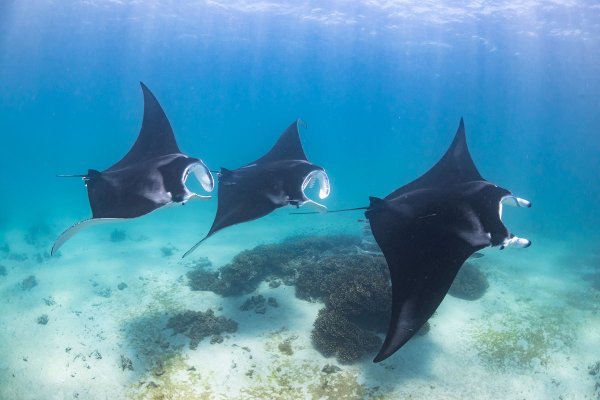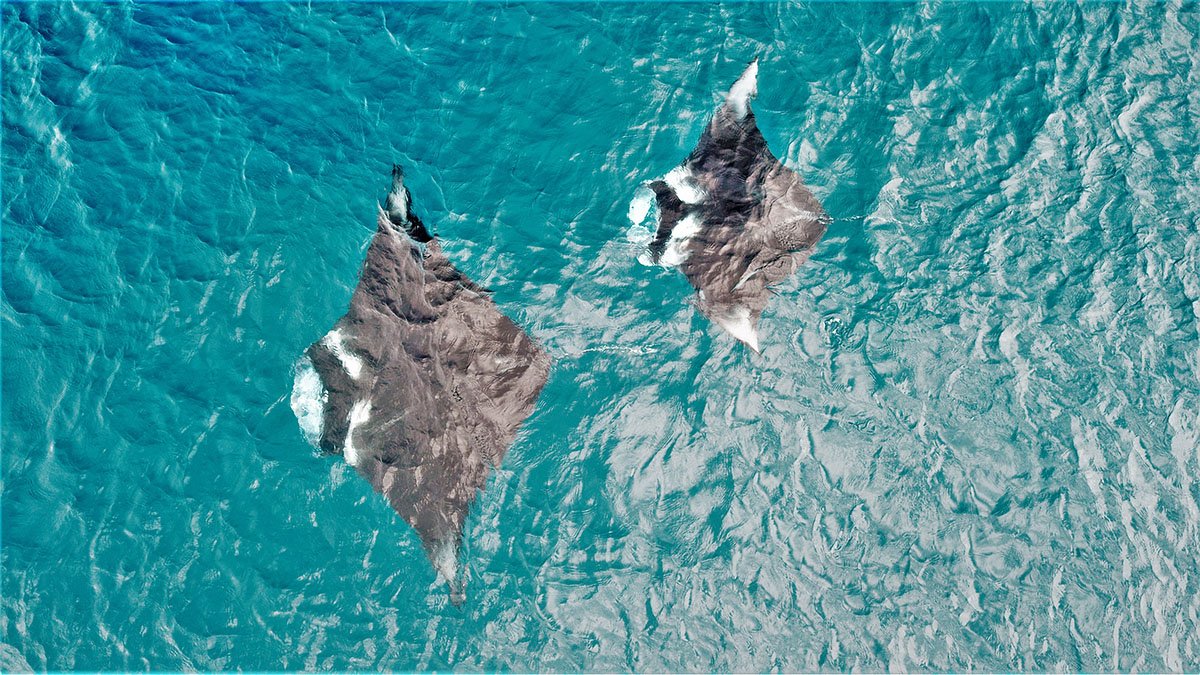Where to see Manta Rays on The Hawaiian Islands
Founder & certified Hawaii travel expert with 20+ years of experience in Hawaii tourism.
This article may include unbiased affiliate links at no extra cost to you. Mahalo for your support!

Places for Viewing Manta Rays in Hawaii
Hawaii is famous for many things, and one of them is for being among the best spots in the world to see manta rays. But you can’t go to just any beach or aquatic spot and see the broad population of manta rays Hawaii has to offer. Fortunately, Hawaii has a plethora of manta viewing spots to offer.
There are places to snorkel and scuba dive at every corner of the islands, along with aquariums ranging from one story to as many as six stories. The rest of the article is a detailed outline of the best places to view manta rays in Hawaii.
Best Snorkeling Spots for Manta Rays
The number one place to see manta rays while snorkeling is off the Kona Coast of the Big Island of Hawaii, especially at night. Kona is famous for its manta ray dives for one main reason, and that is plankton.
Manta rays are attracted to plankton since it’s their primary source of food. In turn, plankton is attracted to light since that’s their main source of food. Wherever the light goes, manta rays go as well.
The coast of Kona is a popular feeding ground for manta rays, meaning you’ll get to see plenty of them as they gracefully flip and turn through the water. The manta rays get remarkably close to their spectators since they’re pretty harmless creatures. As long as you don’t bother them, they won’t bother you.
Snorkeling at Kona Bay at Night
The Kona snorkeling spots become even more spectacular once the sunsets. Since there is no natural light, snorkelers and guides often bring a flashlight or lantern with them. They then shine it at a spot on the sand close to them, drawing the manta ray towards them.
It’s like playing with an aquatic cat and its laser pointer. You get to bring the manta rays to you and connect with them on a much more personal level.
The top four snorkeling spots to see manta rays in Kona bay include:
- Manta village in the south of Kona
- Manta learning center in the Sheraton Kona resort
- Manta heaven in the north of Kona
- Kohala coast resort

FREE 2025 DOWNLOADS
Hawaii Intro Visitor Guide
+ Our Summary Guidesheets!
Includes the top must-see & do attractions, best times to visit, a monthly weather & visitor summary, and our tips on how to save when booking your car rental, tours, and activities. Plus, grab our free Hawaii Summary Guidesheets.

The Original Snorkeling Spot
Manta village was the original manta night dive spot on the island of Hawaii (Big Island), and it still lives up to its name today. It’s the location with the highest rate of manta ray sightings on this list, and tourists see an average of four manta rays a night.
Manta Ray Learning Center
The manta ray learning center is located within the Sheraton Kona resort's grounds, which is only about 15 minutes away from the manta village mentioned above.
The manta ray learning center features exhibits and presentations about everything involving the manta ray, including:
- Manta ray anatomy
- Manta ray life cycle
- The feeding habits and diet of the manta ray
- Behavioral and mating habits
Manta heaven is located right offshore of the Kona international airport. It’s more popular for daytime snorkeling expeditions, but there are still night snorkeling trips that you can go on. Their success rate is slightly higher than the manta village, with tourists seeing about six manta rays each snorkeling trip.
Kohala Coast Resort Hidden Snorkeling Spot
Finally, the Kohala coast resort is somewhat of a hidden gem among manta ray snorkeling spots. Since it’s pretty well hidden and somewhat unknown among tourists, there is a significant lack of other tourists. The other locations have between 50 and 100 people in the water with you at the same time.
At this spot, you can more than likely be the only person in the water. The lack of tourists makes the spot much calmer, attracting more manta rays and more opportunities to get up close and personal to them.

Best Scuba Diving Spots for Manta Rays
If you want to get even deeper with the manta rays, then you can check out one of the many popular scuba diving spots in Hawaii. It usually doesn’t matter if you’re already certified or not, as the scuba diving spot will teach you the basics before you start diving.
The Most Popular Private Scuba Diving Spot
The most popular scuba diving spot for manta rays in Hawaii is Manta Point. Manta point is located in Kauna’oa Bay, which is on the north side of the Kona coast. It has a very high success rate, with tourists seeing between four and six manta rays per dive.
The only problem is that manta point is located within private hotel grounds, so it isn’t open to the public. Thankfully, there are other public scuba diving spots you can go to. But it is recommended that you get scuba certified before diving in these spots.
The Most Popular Public Scuba Diving Spot
The most popular public scuba diving spots are located on the island of Maui, especially in the west area. The two most popular spots are Olowalu Bay and Black Rock Point.
Olowalu Bay is the most popular spot for beginner divers since it is only 35 feet deep. There are plenty of manta rays that frequent the area, but you can see multiple other aquatic life forms, from turtles to octopuses. Olowalu is also famous for its vibrant coral garden, which has been compared to the great barrier reef.

The Best Beginning Scuba Diving Spot
Black Rock Point is another great spot for beginner divers, with it also only 35 feet in depth. But it’s more popular and is less pristine as a result. The main attraction of this dive spot is, of course, the manta rays.
Entire colonies of manta rays flock to this diving spot since it’s a common feeding ground for them and plankton. This spot also offers guided scuba diving tours and expeditions.
Best Aquarium for Manta Rays
The last place to see manta rays in Hawaii are in aquariums. While you won’t get up close and personal to them, there are plenty of aquariums in Hawaii that still make for a good tourist outing. The most popular aquarium for manta rays in Hawaii is the Maui Ocean Center.
The Maui Ocean Center is located in Maui's central area and is the largest aquarium in the western hemisphere. With over 60 exhibits that showcase hundreds of different aquatic life types, this aquarium is like walking through the ocean itself.
As far as viewing manta rays go, this aquarium features a 240-degree tube filled to the brim with hundreds of manta rays. They also do programs for kids to sleepover at the aquarium for the night and see the manta rays during nighttime. So, while you and any other adults are out scuba diving with manta rays, younger members of your vacation party can have the same experience, just drier.
Manta rays can be viewed and interacted with in multiple ways on all of the islands in Hawaii. Even just going to a local beach and snorkeling or scuba diving gives you a pretty good chance of seeing a manta ray in the wild. What makes the above spots special is how close you’ll be able to get to the manta rays and how many of them you will get to see.
The manta rays in the tourist spots above are used to have many people around them, so if you don’t bother them too much, they won’t bother you. When you are snorkeling or scuba diving on your own, you’ll be lucky to see more than two manta rays. But these spots increase your chances exponentially since the spots were picked to be tourist destinations based on the manta ray population.

Affiliate Disclosure: We may earn commissions from some travel partners (like Amazon or Expedia) which helps us maintain this site. These links are at no extra cost to you and don't impact our honest & unbiased recommendations. Remove all the ads →




